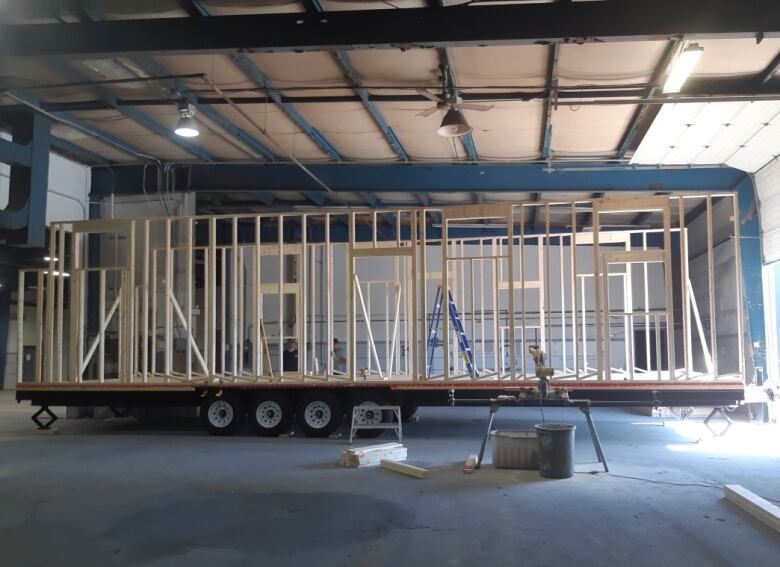More New Brunswickers consider tiny houses during pandemic
Builder notices rising interest in clutter-free, affordable lifestyle

There's growing interest in lifestyle changes amid the economic uncertainty of the pandemic. And in New Brunswick, it's prompting more people to consider tiny houses.
Tiny homes, generally considered about 400 square feet or less, are part of a social movement for simple living. The houses are often built on trailers to allow easy relocation.
Leo Girouard, the co-owner of Wee Bitty Builders, thinks the trend is tied to uncertainty around COVID-19.
The Saint John builder said he's getting a few calls, emails or visits a day from potential buyers. Before the pandemic hit the province — inquiries were occasional.
"We've found there's a lot of young people, first-time home buyers that are looking as a more affordable way to have that first home," he said.
People choosing a tiny house are often looking for a clutter-free lifestyle, where affordable housing allows for greater financial freedom. The homes also typically have a small footprint, which results in low heating and electricity costs.

Houses built by Wee Bitty Builders cost from $35,000 to $80,000, depending on size. The specialty business started in 2016 and has built 18 homes for customers in New Brunswick and Nova Scotia.
The trend has taken off in the last decade, with the help of reality television shows and books on tiny house living. But it's a concept slow to take root in the Maritimes.
"If more people knew these were a possibility around here, I think it would increase even more," Girouard said.
Affordable retirement
Angela Boyd and her husband, Josh Conway, decided to buy a tiny home earlier this year. The Quispamsis couple wanted a summer cottage to become an eventual retirement home, but a traditional build wasn't affordable.
"We figured what better way to do that than a tiny home," Boyd said. "It's on wheels, it's affordable, we can take it wherever we want to take it, and then we can bring it home."
They plan to place the tiny house on family land in Cambridge-Narrows, where the property has been prepared for electricity, water and septic access. It will take 10 to 12 weeks to construct.

Boyd said the pandemic makes the purchase of a tiny home even more appealing compared to a traditional one.
"You could purchase a tiny home for a fraction of that cost and still be able to live comfortably," she said.
The home may be only 400 square feet or so, but it will be able to sleep six people and allow for eight to dine at once. It includes all the regular features of a house, such as a washer and dryer, bathtub and kitchen appliances.
It's less than a quarter the size of the average Canadian home, which is more than 1,700 square feet, according to Statistics Canada.
Brandon McFarlane moved into a tiny house in Dufferin, near St. Stephen, right before the pandemic. He lives alone and wanted a home without a large mortgage, so he could afford to travel.

"I like knowing that I'm using all of that space that I need," he said.
The home was custom-built and registered as a trailer. It's about 360 square feet and has two bathrooms, a full kitchen with a dishwasher, a ground floor bedroom and a sleeping loft.
McFarlane expects the appeal of tiny homes to grow with the pandemic.
"I'm really surprised this hasn't caught on much quicker than it has."
Zoning challenges
Finding a site for a tiny house can be a challenge in New Brunswick.
It's a problem Boyd encountered when she tried to find a site in her area. Regulations in Quispamsis and Rothesay do not permit a model like hers, which will be on wheels.
The solution ultimately involved working with the Village of Cambridge-Narrows to designate the site as a camp.
"I think municipalities need to understand that this is a much more financially feasible way for people to own a home," Boyd said.

Lyndsay Rolheiser, an assistant professor in urban and regional planning at Ryerson University, said zoning often makes it impossible to add tiny homes.
"Many communities, even rural communities, do not allow structures under a certain size and also do not allow moveable structures," she said.
Rolheiser said cities have allowed micro apartments of less than 500 square feet but not standalone structures.
Girouard said most tiny houses in the province are placed on rural land. But customers have also managed to find sites in more developed areas like Saint John and St. Stephen.
"There's still people that just don't even know what a tiny house is," he said. "So when you go to try to get approval for something like that, then there's a process you've got to go through to explain it and educate people."


